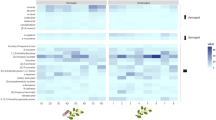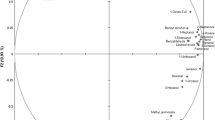Abstract
Upon herbivore attack, plants produce and emit volatile organic compounds (VOCs). Some of these compounds may be used in defensive strategy namely the attraction of the herbivores natural enemies. To increase our knowledge of aboveground-induced VOCs on beneficial organisms, we describe laboratory study on the chemotactic behavior of two-spotted lady beetle (Adalia bipunctata L.) and green lacewing (Chrysoperla carnea [Stephens]) larvae toward synthetic VOCs (methyl salicylate, (E)-β-farnesene, (E)-β-ocimene, and E-nerolidol) typically emitted by insect-damaged peach cultivars. All tested VOCs influenced the behavior of both tested organisms. Our results are suggesting that VOCs can influence the movement of green lacewing larvae only for short period of time, while on the other hand two-spotted lady beetle larvae can follow the chemical signal for longer period of time. Results demonstrate a laboratory attraction of two-spotted lady beetle and the green lacewing larvae to a synthetic (E)-β-ocimene. Furthermore, our study showed a repellency of two-spotted lady beetle and the green lacewing larvae to a synthetic (E)-nerolidol, (E)-β-farnesene, and methyl salicylate.




Similar content being viewed by others
References
Al Abassi SA, Birkett MA, Pettersson J, Pickett JA, Wadhams LJ, Woodcock CM (2000) Response of the seven-spot ladybird to an alarm pheromone and an alarm pheromone inhibitor is mediated by paired olfactory cells. J Chem Ecol 26:1765–1771
Alhmedi A, Haubruge E, Francis F (2010) Identification of limonene as a potential kairomone of the harlequin ladybird Harmonia axyridis (Coleoptera: Coccinellidae). Eur J Entomol 107:541–548
Amorós-Jiménez R, Robert CAM, Marcos-García MA, Fereres A, Turlings TDJ (2015) A differential role of volatiles from conspecific and heterospecific competitors in the selection of oviposition sites by the aphidophagous hoverfly Sphaerophoria rueppellii. J Chem Ecol 41:493–500
Arimura G, Matsui K, Takabayashi J (2009) Chemical and molecular ecology of herbivore-induced plant volatiles: proximate factors and their ultimate functions. Plant Cell Physiol 50:911–923
Bargmann CI, Horvitz HR (1991) Chemosensory neurons with overlapping functions direct chemotaxis to multiple chemicals in C. elegans. Neuron 7:729–742
Boo KS, Chung IB, Han KS, Pickett JA, Wadham LJ (1998) Response of the lacewing Chrysopa cognata to pheromones of its aphid prey. J Chem Ecol 24:631–639
Bowers WS, Nault LR, Webb RE, Dutky SR (1972) Aphid alarm pheromone: isolation, identification, synthesis. Science 177:1121–1122
Danner H, Brown P, Cator EA, Harren FJM, van Dam NM, Cristescu SM (2015) Aboveground and belowground herbivores synergistically induce volatile organic sulfur compound emissions from shoots but not from roots. J Chem Ecol 41:631–640
De Boer JG, Dicke M (2004) The role of methyl salicylate in prey searching behavior of predatory mite Phytoseiulus persimilis. J Chem Ecol 30:255–271
Dicke M, Sabelis MW (1988) How plants obtain predatory mites as bodyguards. Neth J Zool 38:148–165
Francis F, Lognay G, Haubruge E (2004) Olfactory responses to aphid and host plant volatile releases: E-ß-Farnesene an effective kairomone for the predator Adalia bipunctata. J Chem Ecol 30:741–755
Gosset V, Harmel N, Göbel C, Francis F, Haubruge E, Wathelet J-P, du Jardin P, Feussner I, Fauconnier M-L (2009) Attacks by piercing-sucking insect (Myzus persicae Sultzer) or a chewing insect (Leptinotarsa decemlineata Say) on potato plants (Solanum tuberosum L.) induce differential changes in volatile compound release and oxylipin synthesis. J Exp Bot 60:1231–1240
Hardie J, Isaacs R, Pickett JA, Wadhams LJ, Woodcock CM (1994) Methyl salicylate and (-)-(1 R, 5S)-myrtenal are plant-derived repellents for black bean aphid, Aphis fabae Scop. (Homoptera: Aphididae). J Chem Ecol 20:2847–2855
Ishiwari H, Suzuki T, Maeda T (2007) Essential compounds in herbivore-induced plant volatiles that attract the predatory mite Neosiulus womersleyi. J Chem Ecol 33:1670–1681
James DG (2003) Field evaluation of herbivore-induced plant volatiles as attractants for beneficial insects: methyl salicylate and the green lacewing, Chrysopa nigricornis. J Chem Ecol 29:1601–1609
James DG (2006) Methyl salicylate is a field attractant for the goldeneyed lacewing, Chrysopa oculata. Biocontrol Sci Technol 16:107–110
James DG, Price TS (2004) Field-testing of methyl salicylate for recruitment and retention of beneficial insects in hops and grapes. J Chem Ecol 30:1613–1627
James DG, Price TS, Wright LC (2004) Field-testing of methyl salicylate for recruitment and retention of beneficial insects in grapes and hops. J Chem Ecol 30:1613–1628
Kappers IF, Hoogerbrugge H, Bouwmeester HJ, Dicke M (2011) Variation in herbivory-induced volatiles among cucumber (Cucumis sativus L.) varieties has consequences for the attraction of carnivorous natural enemies. J Chem Ecol 37:150–160
Kielty JP, Allen-Williams LJ, Underwood N, Eastwood EA (1996) Behavioral responses of three species of ground beetle (Coleoptera: Carabidae) to olfactory cues associated with prey and habitat. J Insect Behav 9:237–251
Laznik Ž, Trdan S (2016) Attraction behaviors of entomopathogenic nematodes (Steinernematidae and Heterorhabditidae) to synthetic volatiles emitted by insect damaged potato tubers. J Chem Ecol 42:314–322
Laznik Ž, Tóth T, Lakatos T, Vidrih M, Trdan S (2010) Oulema melanopus (L.) (Coleoptera: Chrysomelidae) adults are susceptible to entomopathogenic nematodes (Rhabditida) attack: results from a laboratory study. J Plant Dis Prot 117:30–32
Laznik Ž, Košir IJ, Rozman L, Kač M, Trdan S (2011) Preliminary results of variability in mechanical-induced volatile root-emissions of different maize cultivars. Maydica 56:343–350
Mondor E, Roitberg B (2000) Has the attraction of predatory coccinelids to cornicle droplets constrained aphid alarm signaling behavior? J Insect Behav 3:321–329
Ninkovic V, Abasi SA, Pettersson J (2001) The influence of aphid-induced plant volatiles on ladybird beetle searching behavior. Biol Control 21:191–195
Ozawa R, Shimoda T, Kawaguchi M, Arimura G, Horiuchi J, Nishioka T, Takabayashi J (2000) Lotus japonicus infested with herbivorous mites emits volatile compounds that attract predatory mites. J Plant Res 113:427–433
Rasmann S, Köllner TG, Degenhardt J, Hiltpold I, Toepfer S, Kuhlmann U, Gershenzon J, Turlings TCJ (2005) Recruitment of entomopathogenic nematodes by insect-damaged maize roots. Nature 434:732–737
Rojht H, Kač M, Trdan S (2009) Nontarget effect of entomopathogenic nematodes on larvae of twospotted lady beetle (Coleoptera: occinellidae) and green lacewing (Neuroptera: Chrysopidae) under laboratory conditions. J Econ Entomol 102:1440–1443
Staudt M, Jackson B, El-Aouni H, Buatois B, Lacrozze J-P, Poëssel J-L, Sauge M-H (2010) Volatile organic compound emissions induced by the aphid Myzus persicae differ among resistant and susceptible peach cultivars and a wild relative. Tree Physiol 30:1320–1334
Takabayashi J, Dicke M (1996) Plant-carnivore mutualism through herbivore-induced carnivore attractants. Trends Plant Sci 1:109–113
Turlings TCJ, Loughrin JH, McCall PJ, Ose USR, Lewis WJ, Tumlinson JH (1995) How caterpillar damaged plants protect themselves by attracting parasitic wasps. Proc Nat Acad Sci USA 92:4169–4174
Verheggen FJ, Anaud L, Bartram S, Gohy M, Haubruge E (2008) Aphid and plant secondary metabolites induce oviposition in an aphidophagous hoverfly. J Chem Ecol 34:301–307
Zhang Q-H, Sheng M, Chen G, Aldrich JR, Chauhan KR (2006) Iridodial: a powerful attractant for the green lacewing, Chrysopa septempunctata (Neuroptera: Chrysopidae). Naturwissenschaften 93:461–465
Zhu JW, Cossé AA, Obrycki JJ, Boo KS, Baker TC (1999) Olfactory reactions of the twelve-spotted lady beetle, Coleomegilla maculata and the green lacewing, Chrysoperla carnea to semiochemicals released from their prey and host plant: electroantennogram and behavioral responses. J Chem Ecol 25:1163–1177
Acknowledgements
This work was conducted within Horticulture No. P4-0013-0481, a program funded by the Slovenian Research Agency. Part of this research was funded within Professional Tasks from the Field of Plant Protection, a program funded by the Ministry of Agriculture, Forestry, and Food of Phytosanitary Administration of the Republic Slovenia. Special thanks are given to Nika Lokar and Jaka Rupnik for their technical assistance.
Author information
Authors and Affiliations
Corresponding author
Ethics declarations
Conflict of interest
All authors declare that they have no conflict of interest.
Rights and permissions
About this article
Cite this article
Laznik, Ž., Trdan, S. Are synthetic volatiles, typically emitted by insect-damaged peach cultivars, navigation signals for two-spotted lady beetle (Adalia bipunctata L.) and green lacewing (Chrysoperla carnea [Stephens]) larvae?. J Plant Dis Prot 125, 529–538 (2018). https://doi.org/10.1007/s41348-018-0172-6
Received:
Accepted:
Published:
Issue Date:
DOI: https://doi.org/10.1007/s41348-018-0172-6




